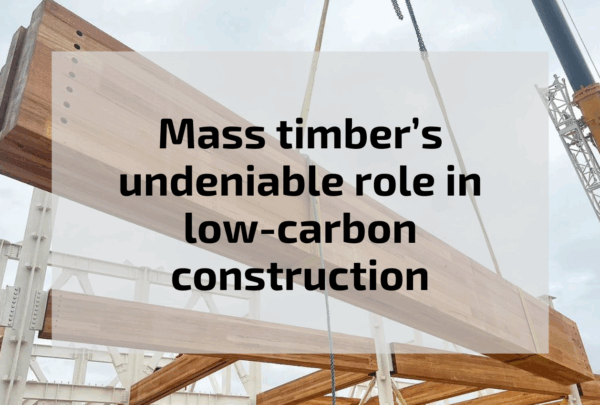A new Environmental Product Declaration (EPD) released for MASSLAM — a laminated timber product made using Tasmanian plantation hardwood by Australian Sustainable Hardwoods (ASH) with fibre from Western Junction Sawmill (WJS) — confirms its potential as a low-carbon structural alternative for multi-res and commercial construction projects.
The findings arrive at a time when the role of embodied carbon in construction is under increasing scrutiny. The Green Building Council of Australia (GBCA), in its recent report Our Homes Weigh a Tonne, found that upfront emissions are now seven times more impactful than operational emissions over a building’s lifespan.
While the report focuses primarily on Class 1a dwellings, it highlights a broader trend that applies equally — and arguably more urgently — to more intensive building typologies – Class 2 (multi-residential) and Class 5 (commercial) buildings.
Upfront emissions from materials like concrete, brick and steel are now the dominant contributors to a building’s total lifecycle carbon.
As the electricity grid becomes greener, early-stage material choices are becoming the dominant factor in determining a building’s whole-of-life carbon footprint.
The newly released EPD for MASSLAM, independently verified under EN 15804 and ISO 14025, demonstrates a net carbon benefit of -748 kg CO₂e for every cubic metre used (A1–A3 stages, including biogenic carbon). This performance doesn’t just come from using renewable raw materials. It reflects a deliberate and integrated manufacturing approach:
This carbon performance compares favourably to conventional structural materials such as concrete and steel, which typically incur substantial embodied emissions during production and early-stage transport.
In practical terms, this means a MASSLAM superstructure delivers a carbon benefit from day one. Traditional materials can require decades of operational savings to offset their initial impact. For projects targeting genuine decarbonisation, MASSLAM provides a substantial head start.
MASSLAM is manufactured using plantation-grown hardwood from Tasmania — fibre originally intended for pulp production but diverted to long-lived structural applications. The MASSLAM plant is capable of delivering the superstructure for the equivalent of 2,000 homes per annum using modern methods of construction (MMC).
The recently released Circularity Gap Report 2025 from thinkstep-anz confirms that despite increased awareness, Australia’s material circularity performance is declining. We’re consuming more and looping less — meaning immediate reductions in material carbon have become more critical than speculative recycling potential.
Mass timber superstructures like MASSLAM don’t rely on a future circular practice to deliver impact. They reduce emissions today, while remaining renewable, bio-based, and recyclable at end of life.
WJS and ASH Director and Business Development Manager, Daniel Wright, says “For project teams — especially those working on government or institutional buildings — this supports a growing shift toward bio-based, renewable materials that offer immediate and measurable reductions in emissions. Unlike many recycled or circular materials that rely on theoretical future reuse, which is yet to be realised, mass timber solutions like MASSLAM offer clear carbon savings at the point of construction”.
“In light of these findings”, Wright says, “some sustainability consultants are reconsidering the allocation of carbon reduction budgets. Instead of prioritising on-site renewable energy for buildings already capable of drawing energy from an increasingly renewable grid, there is an argument for reallocating investment toward a low-carbon structure, particularly where mass timber can displace high-emissions materials”.
Wright hopes this will result in a shift towards a more innovative building approach, explaining, “a large rooftop solar system for example, might reduce future emissions marginally over time. In contrast, replacing a concrete and steel frame with timber can cut several hundred tonnes of CO₂ upfront, based on current life cycle assessment (LCA) data. Mass timber structures can also be delivered 20-30% faster and cheaper, but lack of experience from cost assessors and head contractors comes with added contingency. The potential savings from eliminating rooftop systems might help motivate decision makers to learn a new way of construction”.
As the building sector works toward ambitious emissions targets, verified data like this helps designers, builders, and policymakers make informed, high-impact decisions.
"*" indicates required fields


